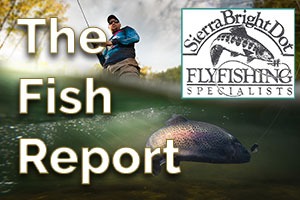
Black Rock Fish Hatchery
Several California Department of Fish and Wildlife (CDFW) fish hatchery facilities in the eastern Sierra and Southern California are battling a bacterial outbreak that has the potential to cause significant losses to both hatchery and wild fish populations. The outbreak of Lactococcus garvieae, which is similar to streptococcus, has sickened fish at the Mojave River Hatchery and has been detected at both the Black Rock and Fish Springs hatcheries. A fourth CDFW hatchery, Hot Creek Hatchery, was originally quarantined out of caution but after testing that quarantine has been lifted.
The L. garvieae bacteria has never before been detected in fish in California, and CDFW must take a cautious and careful approach to ensure the protection of the state’s aquatic resources – fish, hatchery facilities and public waterways. Infected fish can show symptoms including bulging eyes, lethargic or erratic swimming and increased mortality, or be asymptomatic and show no signs of infection depending on a several factors including water temperature and stress. Fish-to-human transmission of this bacteria is rare and unlikely.

Fish Springs Hatchery
Fish stocking has temporarily been halted from the facilities under quarantine while hatchery staff treats the affected fish populations and takes measures to prevent the spread of the bacteria. Planting will resume when fish have recovered from the infections and fisheries pathologists have determined that they no longer present a threat to the environment.
“This is a challenge for our hatcheries because the bacteria is previously unknown in California, and we don’t have tried-and-true strategies on hand to combat it,” said Jay Rowan, environmental program manager for CDFW’s Hatchery Production and Fish Health Laboratory. “A successful approach will have three components: Treating the affected fish at the hatcheries, finding the origin of the outbreak, and planning ahead to contain and prevent the spread of the bacteria. Unfortunately, we may be in for a long battle here, which means there will not be a lot of fish plants in the near future in the eastern Sierra and Southern California. I wish we could give anglers a target date for when we think we can start planting again, but it’s all up to how fast and how well the fish respond to the treatments.”
Current treatment measures at the hatcheries include keeping water temperatures low, reducing stress due to crowding and other factors, introducing antibiotic medication and special diet in order to assist the fish in fighting off the infection. CDFW is currently investigating the source of the outbreak. For additional information, please see CDFW’s frequently asked questions about the L. garvieae outbreak.
Discover more from Sierra Wave: Eastern Sierra News - The Community's News
Subscribe to get the latest posts sent to your email.

















Bring back Alpers!,,
I would like to know how much money it cost to change the name from dfg to dfw money that could have been used to improve the hatcheries. This bacteria is just another excuse for the incompetence of haters personnel. Bring back private hatcheries,they never had these problems
Earl Duran
Your right,things have changed,but..IMO…more like only the last 4 or 5 years or so.
Luckily,I live up here,so I don’t have that draw-back of having to do that long,dangerous drive from about Cal City to the Inyo and Mono Counties.
For us living up here,the biggest change is it seems EVERY day,weekdays,weekends are getting to be more like 3 day holidays through spring,summer and some of the fall.
TONS of people everywhere,tons of traffic on HWY 395,and it seems especially this year,no matter what day of the week or what time of day it is.
And maybe it’s just me,but it seems extra-annoying people and travelers this year.
And more trash being left behind for others living up here to pick up too.
It’s so nice if you can find a quiet spot away from all of that,maybe catch a few fish for dinner,but I swear,when you do,it seems it opens the flood gates to others showing up there,almost like some kind of GPS thing some people have,a “locator” that’s telling them when and where fish are being caught and where to go.
The “quiet spot” you find with no one around soon turns into Grand Central Station,no matter where you’r at…
I guess just another sign-of-the-times we can do little about.
My usual mid-Summer camping- fishing trip has been postponed to mid-September this year….only hoping for the best…maybe kids back in school and many grown-ups back to work or something.
I agree, getting there is half the fun, but over the last 10 years fishing has changed, maybe it is me, or just a sign of the times ,Today I almost got run off the road twice
close to Olancha, people passing on double line heading to the High Sierra, not worth the risk, the bypass around the small town in way over due.
Earl Duran
If you put the $$$ sign in front of every hobby someone might have,it would probably eliminate all of them.
I think for most of us,fishing is a hobby,which includes drives getting to where your going,time spent in the wilderness away from people (if you can nowdays ),pitching the tent,big campfires at night.waking up and fixing a good breakfast,etc.
Whether you catch or not.
I doubt many of us do it as a necessary source of food and for survival ,or a waste of time and money if we happen not to catch.
Fishing is a thing in my past, It is not worth the time and effort, the price to fish is way to high. For some planters. come on now.
This is very long and not current but any information on the subject is a closely guarded secret.
https://www.summitpost.org/phpBB3/fish-eradication-frog-support-through-poison-t66770.html
About 10 years ago the courts decided that Rainbow, Brown, and Brook trout were an invasive species. The first year fish and game cut the annual fish plant in half. The next year, in half again. the next, again and the next year again. Do the math. All this happens above a certain elevation and it’s not very high. I used to fly fish 4 or 5 days a week. Sometimes for 10 or 12 hours a day.
I have not had a fishing licence for 6 years now. When all this first started I saw a yellow legged frog squashed outside the front door of Manor Market.
Are lakes in mammoth privately stocked as well as state stocked or is it only stocked by state
That license fee pays for the hatchery folks who are trying to fix the problem.
Yea…. Guess you are right… but…but… what about the Hundred Bucks wife and i gave in January???? No fishing? Give the license fee back? I don’t know anything anymore…
Dont come back. Seems like a good year for multiple reasons to leave fishing closed.
$51.00 for license. How do I get the money back… Good luck!!! SEE YA NEXT YEAR…. (maybeeee)